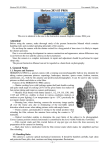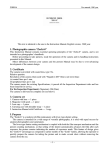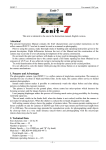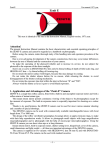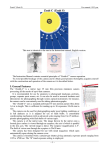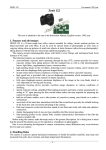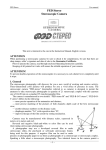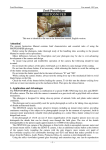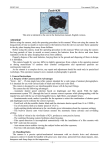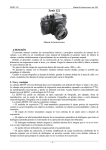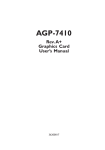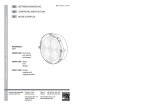Download Horizont
Transcript
Horizont User manual, 1970 year Horizont This text is identical (some errors were corrected) to the one in the User manual, English version, 1970 year. Attention! The present description contains brief characteristics and instructions for care and operation of HORIZONT photographic camera. HORIZONT camera considerably differs from camera of FT-2 type. That is why handling and operation rules should be thoroughly studied by professional photographers as well as by beginners. Minor differences between the description and your camera may be due to technical development of the camera construction. 1. Purpose and Features HORIZONT is a special panorama camera fitted with a rotating built-in lens. Its features offer great convenience in different types of photography, especially in taking pictures of scenes with a large area. Angular field of view of the lens is 120°. Interesting and beautiful pictures of landscapes, various architectural ensembles, monuments and panoramas may be made with this panorama camera. The negative size (24×58 mm) enables to print photos with the help of universal enlargers for 6×6 cm, 6×9 cm negatives. Optical viewfinder allows to determine correct limits of a photographed object. Correct camera position — strictly horizontal — is indicated by the spirit level seen in the viewfinder. The detachable grip offers greater convenience in photographing. The design of HORIZONT camera shutter has one specific feature: when the exposure time is changed, the shutter speed remains the same. The exposure time is varied due to changing the shutter slit. 2. Specifications Frame size: 24×58 mm Width of perforated film: 35 mm Number of frames: 21 Exposure times: 1/30, 1/60, 1/125, 1/250 sec Angular field of the lens: horizontal — 120° vertical — 45° Lens: OF-28P Focal length: 28 mm –1– Horizont User manual, 1970 year Relative aperture: f/2.8 to f/16 Optical viewfinder: eyepiece magnification — 0,4x angular field of view — 110×44° Spirit level accuracy: 5° Tripod socket thread: 1/4ʺ Weight (with the cassette loaded with film): 1025 g 1. Lens 2. Bracket for attaching the viewfinder 3. Viewfinder 4. Viewfinder spirit level 5. Screw of the grip 6. Grip 7. Film reverse rewind knob 8. Exposure time scale 9. Film speed reminder 10. Diaphragm scale 11. Indicating mark of diaphragms and exposure times 12. Release button 13. Shutter setting knob with exposure counter 14. Camera cover lock 15. Tripod bush 16. Cassette chamber 17. Cassette spool guide 18. Film guide roller 19. Film gate 20. Film slide 21. Falling in button –2– 22. Sprocket 23. Take-up spool 24. Take-up spool slit 25. Folding back cover Horizont User manual, 1970 year 3. Loading the camera Do not load the camera in direct sun light. It should be loaded and unloaded in subdued light. To load the camera act as follows: 1. Remove the viewfinder 2. Open the back cover having pulled down the lock latch. 3. Press the film rewind knob and turn it against the direction shown by the arrow. Pull the knob up as far as it will go; then remove the cassette. The HORIZONT camera is designed for using standard cassettes. It is not recommended to use cassettes consisting of two cylinders. 4. Load the cassette with film. If the latter has not a standard-cut end, cut it in the way shown in the picture. 5. Carefully insert the film end under the guide roller and pull about 15 cm of film from under it. 6. Put the cassette into the chamber, having pulled up the film rewind knob as far as it will go. 7. Pass the end of the film under the sprocket so that it appears from under the take-up spool. To make the process of drawing the film easier, press the falling in button and rotate the sprocket with your finger thus moving the film to the take-up spool. –3– Horizont User manual, 1970 year 8. Insert the end of the film into the take-up spool slit and, rotating the take-up spool with your finger, slightly tighten the film. 9. Return the film rewind knob to its initial position and fix it by turning in the arrow direction. 10. Set the shutter by turning the shutter setting knob as far as it will go. Press the release button. Tighten up the film on the take-up spool. 11. Close the back cover. If the camera is loaded correctly, the film rewind knob will spin. If not, check the camera for correct loading. It is possible that the film end left the take-up spool slit. In this case, reload the camera. 12. Set the exposure counter at the red line. To do this lift the winding knob up to the stop and, turning the lower disk, align the red line with the index on the winding knob. 13. Wind the film till figure 1 appears in the window of the exposure counter. 14. Not to forget the sensibility of the film loaded in your camera, set its value in the window of film speed reminder. 4. Taking the Picture –4– Horizont User manual, 1970 year To obtain photos of high quality mount the camera on the tripod. When photographing hold the camera in the way shown in the picture. Otherwise you will often photograph your own fingers. If you want to photograph with the camera mounted on the tripod, the grip should be removed. For this aim screw off the grip screw and put the grip into the carrying case. Before taking a picture set the desired exposure time and diaphragm value against the index. The exposure time dial and the diaphragm scale have one and the same index at the top of the camera against the exposure time dial. The latter can be rotated only in small limits; each position of the dial is fixed. Exposure time and diaphragm may be set only with the shutter cocked. Each position of the diaphragm is fixed. To obtain high quality pictures small diaphragm openings should be preferred when determining the exposure, i. e. it is advisable to use the smallest possible diaphragm and a longer exposure time. Looking through the viewfinder eyepiece, compose the scene to be photographed. Correct horizontal position of the camera ensures a perspectively correct picture of the subject. For this aim the ball of the spirit level should be placed in the contour of the light circle. If you can not see the ball, carefully change the position of the camera so that the ball appears in the circle. When taking vertical pictures, the level is not used. The release button should be pressed smoothly. Correct position Wrong position –5– Horizont User manual, 1970 year 5. Unloading the Camera When the exposure counter shows number 21, the exposed film should be rewound into the cassette. To do this, act as follows: 1. Remove the viewfinder. 2. Press the film rewind knob and turn it against the direction, shown by the arrow. 3. Disengage the shutter setting mechanism. For this aim press the film rewind button to fix it in its extreme lower position. When doing this, the shutter should be released. Rotating the film rewind knob in the arrow direction, rewind the film into the cassette. All the film being rewound into the cassette, the knob becomes easier to rotate. 4. Open the back cover of the camera. 5. Pull the rewind knob upwards to the stop and remove the cassette. 6. “Horizont” Outfit The camera set comprises: – the camera itself; – detachable viewfinder; – grip; – carrying case with a shoulder strap; – cable release; – cassette. –6– Horizont User manual, 1970 year The picture is taken with “HORIZONT” camera. The picture is taken with “ZORKI-4” camera. 7. Camera Care The camera should be handled carefully. Keep it clean, protect from sharp jolts, moisture and sharp temperature fluctuations. Do not keep the camera for a long period of time with the shutter cocked. Thus you will save the spring. Wind the shutter always to the stop. Keep the camera in a closed carrying case. The grip should be removed and fastened to the case cover. Before rewinding the film, remove the viewfinder and put it into the carrying case. Do not touch the optical surfaces with hands as this may cause deterioration of the coating. The coated optical surfaces should be cleaned only with a clean soft cloth or cotton wool, slightly moistened in alcohol. Since the camera is a complicated optical mechanical device, it should be repaired and adjusted only by highly trained specialists and in repair shops. 8. Depth of field table for the lens of “Horizont” camera Diaphragm Depth of field (m) Depth of field (ft) 2.8 5.5 ÷ ∞ 16.5 ÷ ∞ 4 3.9 ÷ ∞ 11.7 ÷ ∞ 5.6 2.9 ÷ ∞ 8.7 ÷ ∞ 8 2÷∞ 6÷∞ 11 1.5 ÷ ∞ 4.5 ÷ ∞ 16 1÷∞ 3÷∞ http://eugigufo.net/en/download/photovideo/ –7–







